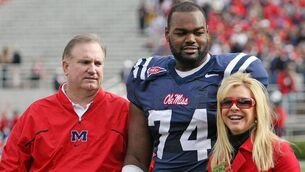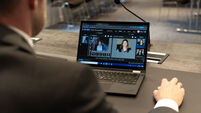Ian Mallon: Why World Cups don’t matter to Irish rugby’s surging $150m brand value

VALUE SURGING: IRFU chief executive officer Kevin Potts during an Ireland rugby media conference at the Aviva Stadium in Dublin. Photo by Piaras Ó Mídheach/Sportsfile
Irish rugby is now the world’s fastest growing brand among all Union nations, more than doubling in value from $77.7m to $150.4m in the four years between Japan 2019 and France 2023.
The IRFU sits at an all-time high of fourth in the sport’s overall most valuable table, and perhaps most interestingly is two places ahead of world champions South Africa.
While the data was compiled between the Springboks consecutive RWC wins, it gives us a fascinating examination of the unimportance of a Rugby World Cup when it comes to image and sponsorship valuations.
If anything, a World Cup is a costly affair for a participating nation, with little by way of financial reward.
The IRFU will get just north of €1m for its efforts in France, while the federation will bear €10m operational costs from the competition. In order to properly analyse the methodology and metrics which have turned Irish Rugby into an indominable force, let’s first look at the Brand Finance – Rugby 10 2023 findings which reveal Union’s new commercial hierarchy.
2023's most valuable rugby brands are: 1. New Zealand $282m; 2. England $263.8m; 3. France $159.4m; 4. Ireland $150.4m; 5. Wales $131.6m; 6. South Africa $117.2m; 7. Australia $100.5m; 8. Scotland $54.2m; 9. Japan $22.9m; 10. Italy $22.4.
Despite an uncharacteristic cycle between Japan and France, the All Blacks stay as the number one rugby brand with a $282m valuation, while South Africa’s slip into sixth place is primarily caused by Ireland and France’s upward surge.
Each position is based on a ‘balanced scorecard of metrics’ which includes marketing investment, social media, stakeholder equity (and heritage) and crucially business performance - sponsorship, merchandising and other commercial activity.
We’ll delve deeper into this a little later, but it is also worth mentioning a second table by Brand Finance - Top 10 Strongest National Rugby Brands. Here too the All Blacks scored highest, with a AAA rated score of 88.9 out of 100, having dropped six points on its 2019 performance, with England the only other AAA-positive performer on 87.6 points.
Ireland rise from seventh to fifth in the ratings table with a AA+ assessment of 78.0, behind France (83.9) and South Africa (81.5) both AAA- and a considerable margin ahead of Wales (74.9) and the Wallabies (73.0).
For now, let’s stick with the overall valuation survey and how Ireland has risen by 94 per cent in brand value. This is down to several factors but most importantly our performance in the Six Nations – a competition which bears more influence to the side’s financial worth than any the World Cup.
This year saw a fourth Grand Slam winning performance, a 15th Championship title and a 13th Triple Crown, all being sealed at home, providing extra ‘live’ visibility to fans and added colour and atmosphere to international broadcast audiences.
Along with such premium brand recognition and actual activation, there is the added value of potential growth and forecasted appreciation.
Since the Brand Finance analysis was published the IRFU has just revealed the overall financial health of the sport here to be in a strong position – while income is down from €116m to €92m for the previous financial year (due to a loss of Covid grants) the deficit is €6.4m ahead of budget, sitting at just €1m.
Income reduced considerably again for the current financial year, with the loss of the Autumn Series of matches (due to the World Cup) and that €10m overhang on costs from France – but there is an extra Six Nations home fixture in 2024, which will ease the burden.
An area that deserves greater scrutiny is how Brand Finance assesses its commercial brand values through sponsorship, merchandising and other commercial activities.
During RWC 2023 the IRFU announced a number of deals agreed - or extensions of current contracts - including a four-year build of its headline sponsorship with Vodafone, an arrangement we estimate to be now worth approximately €25m.
Brand Finance puts some stock in how many sponsors each rugby nation holds but it’s never quantity and always financial quality when it comes to corporate associates. For example South Africa sit on top of this segment with 33 commercial partners, while Wales are second with 30, with England (20) and Ireland (19) in ninth and tenth place.
However, when it comes to revenue generated through commercial and sponsorship Ireland and England are joint second with France on €33m, with New Zealand way out in front with an astonishing €80m.
We know from its current financial statement that the IRFU makes most of its money through game revenue – ‘Representative Matches – with this figure sitting at €86m. This will include all stadium revenue and broadcast-related fees, directly from the November internationals and other tests, and indirectly through its Six Nations Championship rights fees and other arrangements through CVC Capital.
Other income, including sponsorship, achieves €6.1m – although this does not include the new terms of the Vodafone extension.
To assess the strength of the Irish Rugby brand, a scorecard of metrics is used which is then benchmarked against competitors, to arrive at a single ‘Brand Strength Index’. This assessment includes actual matchday, broadcast and distribution fees, as well as sponsorship, along with forecasted revenues.
Final values are achieved by then calculating based on present value and a forecast stream of royalties - what a rugby nation is paid now and what it will achieve over the next four years.
Based on current trends and Ireland’s upward surge in value, Irish Rugby could be worth up to €300m in brand value alone by the time Australia 2027 comes around.
Long overdue, for an award system in just its third year, but finally the USPGA Tour have recognised Rory McIlroy for his incredible impact on American golf.
As predicted on these pages in recent week, the ‘Tour finally needed to recognise McIlroy following a year of duplicity and double cross where Rory batted on behalf of the Tour against the rise of the Saudi-backed LIV Tour, only for Commissioner Jay Monahan to do a deal behind the player’s back.
Tiger Woods has been the only winner of the Player Impact Programme in its previous two years, but finally Rory’s time has come, and with it a $15m first prize – from a purse of $100m shared amongst the Tour’s most influential stars.
It’s easy to be cynical and say that Rory should have been crowned the winner last year, particularly after winning the FedEx Cup and Europe’s equivalent golf championship the Race to Dubai, in the same season.
Is the USPGA Tour finally showing some common sense?
Fresh from Katie Taylor’s majority points win against Chantelle Cameron all eyes are immediately focused on a rematch at Croke Park next summer.
As things stand and barring some serious turn of events, such a fight will not take place at the country’s largest stadium.
This will come down to three key issues – security costs (too high), ticket sales (too unpredictable) and GAA Championship (too much of an issue).
Such a combination is likely something that even Katie Taylor can’t manoeuvre past.









